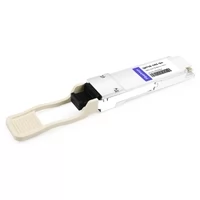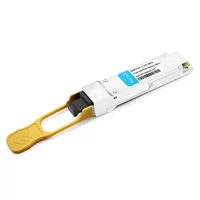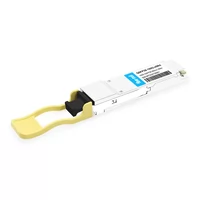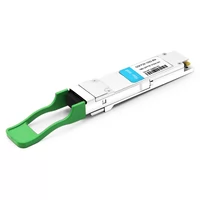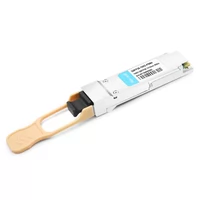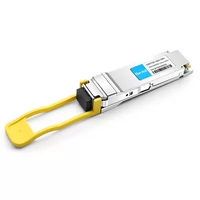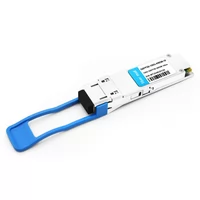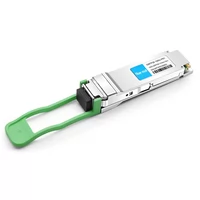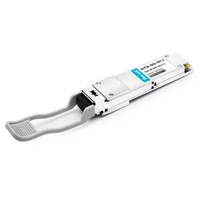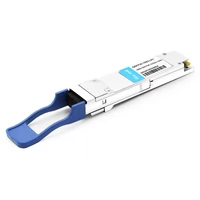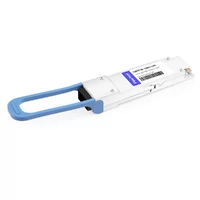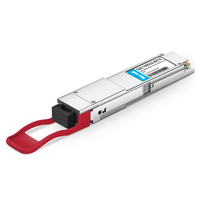Staying on top of change in data centers is essential to efficiency, scalability, and peak performance. One way to achieve this is through using 100GbE ethernet switches, also described as a game changer by this article. We’ll look at what they can do for your data center in terms of technical advantages, such as more bandwidth and less latency, along with potential savings on costs and future-proofing benefits. With such robust switches being so important, it only makes sense that businesses should be ready to deal with vast amounts of information that will come their way sooner or later.
Table of Contents
ToggleWhat is a 100GbE Ethernet Switch?

Understanding the Core Functionality of Ethernet Switches
Ethernet switches are central to intelligent data forwarding across networks by sending packets to their right destinations. A 100GbE Ethernet switch is a type of Ethernet switch with a speed of 100 gigabits per second, which is much higher than that of slower-speed switches, thus making it perfect for contemporary data centers. These high-performance machines use numerous ports to concurrently deal with massive network traffic, thereby reducing congestion and improving the overall efficiency of transferring information. 100GbE Ethernet switches have been designed with advanced switching capabilities like Quality Assurance (QoS), load balancing as well as redundancy features so that they can guarantee uninterrupted connections throughout the data centers, which in turn allows them to process large volumes of data at once while still being able to handle big scale transmission tasks too.
Advantages of Using a 100GbE Switch in Modern Networks
- Utilizing open ethernet switches from NVIDIA networking can potentially increase data transfer speed. A 100GbE switch has the most obvious benefit of higher bandwidth support. These switches can process large amounts of data at a speed rate of 100 gigabits per second, which is needed for modern applications such as high-frequency trading, cloud computing, and data analytics.
- Latency reduction: 100GbE switches greatly reduce latency compared to their lower-speed versions. This feature is important in real-time data processing applications where high-speed transfers are required, ensuring quick delivery across networks.
- Scalability improvement: These switches provide better scalability for growing network needs. When organizations expand their activities and the volume of information grows, performance should not be compromised while scaling seamlessly, which is precisely what this device does best, allowing companies to future-proof their network infrastructure.
- Better efficiency within networks: Service quality integration and load balancing optimization, among other features intended for traffic management, are done by QoS-enabled 100GbE switches, thus improving network performance overall. It helps in faster transmission of data packets through different routes so that all types of traffic reach their destination without delays, which makes the entire system more reliable.
- Cost effectiveness: Although they may require higher initial investments, over time, 100GbE switches prove cost-effective by reducing the number of slower devices needed and simplifying network architecture. This leads to fewer operational management expenses and decreased intricacy in maintaining such networks.
To recapitulate, the installation of 100GbE Ethernet switches into contemporary networks delivers significant advantages like enhanced bandwidth availability, reduced latency periods, increased scalability potentialities, better efficiency throughout networks, and saving costs for long-term use, thereby making them indispensable components within any high-performance-based data center designed to meet present-day future demands in storage requirements.
Comparison of 1U Open Ethernet Switches vs. Traditional Models
- Flexibility: By using an open architecture, 1U Open Ethernet Switches (which can be customized and programmed for different network configurations) are more flexible than conventional ones whose software is private.
- Cost: Compared to traditional models, this type of switch offers a cheaper solution because it has lower licensing fees and is compatible with third-party software. The other one may cost more due to its use of proprietary hardware and software licensing.
- Management: Unlike traditional models, which require specific management tools and thus lead to potential vendor lock-in, 1U Open Ethernet Switches support advanced management and automation tools through open networking standards, allowing easy integration within heterogeneous network environments.
- Performance: These two switches deliver high-performance levels but achieve them in different ways. For instance, while both types have an equal chance of optimizing their performances based on particular network needs, only those that conform to an open architecture like 1Uswitch can do so.
- Scalability: This modular design enables them grow with future demands easily since they are adaptable enough even for larger networks such as those found in big organizations. On the other hand, traditional models would need complex upgrades or replacements in order to scale up properly unlike an NVIDIA open ethernet switch which does not require this.
How to Choose the Right 100GbE Switch?

Key Specifications to Consider: Ports, Speed, and Throughput
When I choose a 100GbE switch, there are a few specifications that I need to consider so that it can meet my network requirement in the best way possible.
Ports: The number of ports is significant since it controls how many connections the switch can make per unit of time, thus enabling port density for full network utilization. Hence, I am looking for switches with enough 100GbE ports to cater to my current and future needs.
Velocity: It is one more vital element. Such switches should consistently maintain high-speed performance to maintain good data transfer rates and support bandwidth-intensive applications.
Throughout, this shows the total data rate capacity of a given switch. Therefore, I give priority to switches with large throughputs because they help optimize networks’ efficiency by eliminating any possible transmission bottlenecks.
Having considered these factors carefully, I will be able to select a 100GbE switch confidently, knowing that it offers strong performance levels coupled with scalability features necessary for the effectiveness of my network infrastructure.
Importance of Connector Airflow and Cooling Solutions
The primary concern while installing 100GbE switches is adequate connector airflow and cooling solutions that guarantee the performance and durability of network parts. An ideal operating temperature is maintained through good airflow management, which prevents overheating, leading to breakdowns in hardware and inefficiency. In addition, cooling systems like advanced heatsinks or strategically located fans help dissipate more heat,, which further safeguards the switch against thermal stress. Therefore, it is essential for you to make sure your switch has strong cooling abilities and allows efficient connector airflow paths if you want to keep up dependable high-speed networks, thereby minimizing chances for expensive downtimes or fixes.
Benefits of QSFP28 Ports in High-Density Data Centers
For several reasons, an open Ethernet switch by NVIDIA networking that incorporates QSFP28 ports is advantageous in high-density data centers. First, it is highly scalable because it can support 100GbE, 50GbE, and 25GbE connections and accommodate different network needs. Secondly, being compactly designed, QSFP28 modules can achieve higher port densities, which maximize space utilization, thereby allowing for more connections per switch, especially in crowded environments. This saves money on hardware and simplifies cable management since fewer cables will be used overall. Thirdly, besides consuming less power while delivering better performance, these ports also help conserve energy in large-scale operations where electricity bills are significant cost drivers. Generally speaking then, integrating QSFP 28 ports into any system guarantees operational agility improvements alongside reduced costs of ownership without forgetting about increased data rates which have become a necessity these days given how much information needs processing within short periods at most modern data centers
What are the Benefits of Using Cumulus Linux?

Customization and Flexibility with Linux Operating Systems
Cumulus Linux and other Linux operating systems are the most flexible and customizable platforms available today which is why they are preferred in modern data centers. To start with, it’s possible to adjust any part of an open-source system like Linux so that it works best for a particular network. In other words, this means that you can tune your software towards your own hardware as well as operational requirements, thereby achieving the utmost efficiency in terms of resources and performance alike. Moreover, there exist many networking applications supported by Linux, hence making them easy to integrate through scripting or programmable interfaces, thus enabling automation for complex network setup management tasks too. Another good thing about Linux is that it has a solid community support base with vast amounts of shared knowledge which usually comes in handy during troubleshooting or when trying out new ideas since people can learn from each other’s mistakes easily due to extensive documentation around such issues. In general, therefore, these features enable enterprises to create scalable, efficient, and high-performance infrastructures for their networks using Linux systems.
Integration of Cumulus Linux on Open Ethernet Switches
The adoption of Cumulus Linux on open Ethernet switches carries plenty of advantages, particularly because it follows open networking principles. It can convert any cheap commodity hardware into a powerful network switch with lots of capabilities by using what the Linux kernel has to offer. This method is able to work with present tools and applications seamlessly which makes them devoid of proprietary restrictions while enabling cheaper networks as well. Additionally, automation tools like Ansible, Puppet, or Chef, among others, may use the standardized Linux environment for quick deployments and configuration changes across the network, too. To add on, different switch hardware platforms can be used for compatibility purposes where various hardware abstraction layers are supported in cumulus linux. Such kind of flexibility allows administrators to optimize resource utilization as well as performance through tailoring deployments based on specific needs since this can be done at different levels within an organization’s infrastructure hierarchy. In summary; integrating Cumulus Linux onto open Ethernet switches enables enterprises build highly flexible, efficient, and scalable network infrastructures
Case Study: Open Ethernet Switch with Cumulus Linux
Context
A major telecommunications firm sought to update its network infrastructure for coping with the increasing data traffic and improving operational efficiency by introducing an open ethernet switch from NVIDIA. The main task was to replace old-fashioned, closed switches with a more flexible, scalable and cost-effective solution that can be seamlessly integrated into existing systems as well as support future growth.
Solution Implementation
The organization opted for Open Ethernet Switches integrated with Cumulus Linux in order to meet these goals. This method allowed them to use off-the-shelf hardware while taking advantage of the rich networking capabilities provided by the Linux kernel itself. In their deployment of Cumulus Linux, they saved significantly on costs by reducing vendor lock-ins and gaining the ability to automate network configuration using Ansible. With different hardware abstraction layers being used, it became possible to ensure compatibility across various models of switches, thereby enabling custom deployments based on performance optimization.
Results and Benefits
What resulted was a network infrastructure that is robust, scalable, and highly adaptable due to the integration of Cumulus Linux on open Ethernet switches. The telecommunications company experienced immediate as well as long-term benefits, such as improved network performance and lower operational expenses, among others, while managing their networks flexibly at scale. Thus, according to Linux, the standardized environment quickened the deployment process, making it easy for them to adjust rapidly toward changing demands within networks.
Modernizing its network infrastructure using Open Ethernet Switches and Cumulus Linux enabled the business to align itself better with present-day advancements in technology and those expected in the future, key among these being upgrades provided by Nvidia open ethernet switches.
Why Choose a Switch from NVIDIA?

Overview of NVIDIA Networking Solutions
NVIDIA Networking offers various advanced products designed to improve performance, efficiency, and scalability in data centers. NVIDIA’s high-speed Ethernet and InfiniBand switches, which are low latency and high throughput optimized, among other cutting-edge technologies, are accessible. These can be used for different applications ranging from AI/machine learning workloads up to HPC (high-performance computing) and cloud infrastructures as well. Moreover, strong software support is provided by NVIDIA Networking, including Cumulus Linux, which guarantees network automation without any hitches and flexibility being easily managed while at it, too. This all-encompassing approach to networking ensures that there is a solution for every type or size of problem in a contemporary data center, according to NVIDIA’s vision.
Features of Mellanox 100GbE Switches
Mellanox 100GbE switches are packed with features that are meant to optimize network efficiency and performance, especially in areas where there is high demand for these services. They can scale up more than any other type of switch and hence can provide bigger bandwidths that support speeds of up to 100Gbps per port. This makes them perfect for cloud computing infrastructures and data centers. The switches come with superior congestion management abilities and advanced QoS (Quality of Service) capabilities, thus ensuring a continuous flow of information even when the networks are overloaded.
Additionally, they offer extensive programmable switching support and network automation, which has been made possible by their integration into Cumulus Linux. This combination will streamline operations and simplify management, allowing networks to easily adapt to current demands or future technological changes.
These features improve network performance and user experience by ensuring availability at its peak while keeping latency at minimum levels, which is crucial for AI (Artificial Intelligence), machine learning, and other high-performance requirements.
Cost-Effectiveness and Performance of NVIDIA’s 1U Switches
When looking at the cost-effectiveness as well as functionality of NVIDIA’s 1U switches, it becomes clear that they offer a good blend of affordability and high performance. The switches have been built with great throughput and low latency in mind thus making them ideal for data centers with heavy workloads; moreover, these open ethernet switches from NVIDIA also bring about some extra flexibility. They are small in size, which means that space will not be wasted but used optimally, while their advanced functionalities like net automation support plus ease of management greatly minimize operational costs. More so is how this works hand in hand with Cumulus Linux, where integration leads to faster and more flexible network changes when needs arise. According to various sources, including major tech reviewers’ sites there is no doubt about getting value for money invested here because such investments do not require sacrificing on capacity or performance due budgetary constraints even leading organizations can afford them too.
How Does 100GbE Technology Transform Data Center Operations?

Increasing Data Center Efficiency with High-speed Networks
Modern infrastructure needs high-speed networks, such as 100GbE technology, because they transform data center operations significantly by improving efficiency in various ways. First of all, the enhanced bandwidth capacity facilitates faster rates of data transmission; this smoothens the handling of massive amounts of data and reduces bottlenecks. Open Ethernet switches from NVIDIA are the best hardware choice for such kinds of applications, which require a lot of data processing like AI, machine learning, or big data analytics. Another thing is that low latency is very important in real-time decision-making processes where quick response time is required; hence, these types of networks can be used there, too. Moreover, deploying 100GbE technologies helps utilize network infrastructures better thus cutting down on operational costs and energy consumption since fewer devices will be needed to deal with equal traffic volumes. These improvements in performance and efficiency support not only current needs but also prepare data centers for future workload growths that may arise.
Lowering Latency and Improving Throughput
Enhancing data center performance involves decreasing latency and increasing throughput. This can be achieved by using 100GbE technology, which increases the speed of sending packets by transferring more data within a given period across the network. Latency is reduced as switches process things quicker and routes become more efficient. Thus, this minimizes delays when transmitting information. Throughput improvement takes place because there is a wider bandwidth that allows for simultaneous congestion-free handling of additional amounts of data throughout the network. Consequently, these enhancements quicken the availability of information, heighten application efficiency, and optimize resource utility besides being necessary for extreme computing environments based on 100GbE technology.
Future-Proofing Your Infrastructure with 100GbE Ports and Cables
Making your infrastructure future-proof involves the use of 100GbE ports and cables. This way, you make sure that your network can meet the ever-growing requirements for modern as well as upcoming applications. Investing in 100GbE technology means equipping your data center with the capabilities of handling more significant amounts of data at higher speeds while demanding lower latency. Scalability like this becomes necessary because it supports growth without frequent replacements due to technological changes. Another thing about these components is their energy-saving ability, besides being cost-effective, thus reducing operational costs but not compromising performance levels. If one integrates 100GbE into his or her infrastructure, then they can be assured that their system will always be competitive enough to satisfy new business demands.
Reference Sources
Frequently Asked Questions (FAQs)

Q: What is a 100GbE Ethernet Switch and how can it revolutionize my data center?
A: A 100GbE Ethernet Switch, such as the HPE SN2100M 100GbE, utilizes 100-gigabit-per-second (Gbps) speeds to greatly improve network performance. This has the potential to transform your data center by allowing quicker transfers of information, reducing latency, and increasing bandwidth, thereby supporting heavier workloads while ensuring better overall efficiency.
Q: What are the benefits of using the HPE SN2100M 100GbE in my data center?
A: It provides high-speed connectivity with its 16 QSFP28 ports and features such as p2c airflow management support. It is based on a 1u open ethernet switch with 100gbe, which offers the flexibility, scalability, and high performance needed for modern-day data centers.
Q: How does the connector airflow half-width switch design impact performance?
A: By enabling cooling within the confines of a connector airflow half-width switch design, lower temperatures are achieved in any given environment. Hence, this has positive implications on overall performance, both short-term and long-term, vis-a-vis network hardware lifespan extension, where minimum power consumption is also realized.
Q: What are the key specifications of the HPE Storage Switch M-Series SN2100M?
A: The main features include high-speed connectivity provided by sixteen QSFP28 ports, the ability to support various applications that require higher performance levels thanks to its capability of delivering up to 100Gbps, and efficient cooling via power-to-connector-airflow-half-design, which helps keep up reliable robustness within infrastructure related to storage switches m series sn2100m hope.
Q: What is the difference between the HPE SN2100M and other 100GbE 1U open Ethernet switches?
A: Energy-saving characteristics, together with compactness, make HPE SN2100M 100GbE different from other switches of its kind; it also performs better due to features like p2c airflow management, among many others, and it has 16 QSFP28 ports, which are considered more reliable than most options available for use in a data center.
Q: Can the HPE SN2100M 100GbE switch be incorporated into existing 10G networks?
A: The HPE SN2100M 100GbE switch is compatible with 10G networks. This means that you can easily integrate them without any hitches. It has various interfaces, including sfp28 connectors, which support 10G connections, making it an ideal choice for upgrading the data center into a 10g switch environment.
Q: Where can I get more information about or purchase the HPE SN2100M 100GbE switch?
A: To buy Nvidia networking products like the HPE SN2100M 100GbE switch, you should check out some online stores such as fs.com Europe or maybe even through specialized distributors of said product like the Nvidia networking store. Alternatively, you may visit the HPE Store for further details.
Q: What is p2c airflow, and why is it essential for 100GbE switches?
A: P2C Airflow stands for Power to Connector Airflow; this cooling system directs air from power supplies toward connectors. This cooling helps keep temperatures within optimum ranges, thereby maintaining reliable operation in dense data center environments where many devices are tightly packed together. Hence, it is necessary for the excellent performance of any 100GbE switch.
Q: Does the HPE SN2100M 100GbE come with energy efficiency benefits?
A: Yes, among its peers, the HPE SN2100M is built with power-saving features in mind. Thus, it is highly energy efficient and requires minimum power during normal operations. This greatly reduces the overall costs associated with powering up data centers and cooling them down again.
Q: How many gigabit ethernet connections does the HPE SN2100M support?
A: The HPE SN2100M supports up to sixteen QSFP28 ports, which can be used as gigabit ethernet connections. With such a high port density, it is possible to fully use the network capacity, facilitating quick data transfers and effective network management.
Related Products:
-
 QSFP28-100G-SR4 100G QSFP28 SR4 850nm 100m MTP/MPO MMF DDM Transceiver Module
$40.00
QSFP28-100G-SR4 100G QSFP28 SR4 850nm 100m MTP/MPO MMF DDM Transceiver Module
$40.00
-
 QSFP28-112G-SR4 112G OTU4 QSFP28 SR4 850nm 100m MTP/MPO MMF DDM Transceiver Module
$50.00
QSFP28-112G-SR4 112G OTU4 QSFP28 SR4 850nm 100m MTP/MPO MMF DDM Transceiver Module
$50.00
-
 H3C QSFP-100G-eSR4-MM850 Compatible 100G QSFP28 eSR4 850nm 200m on OM3/300m on OM4 MTP/MPO MMF DDM Transceiver Module
$75.00
H3C QSFP-100G-eSR4-MM850 Compatible 100G QSFP28 eSR4 850nm 200m on OM3/300m on OM4 MTP/MPO MMF DDM Transceiver Module
$75.00
-
 QSFP28-100G-IR4 100G QSFP28 IR4 1310nm (CWDM4) 2km LC SMF DDM Transceiver Module
$110.00
QSFP28-100G-IR4 100G QSFP28 IR4 1310nm (CWDM4) 2km LC SMF DDM Transceiver Module
$110.00
-
 QSFP28-100G-PSM4 100G QSFP28 PSM4 1310nm 500m MTP/MPO SMF DDM Transceiver Module
$180.00
QSFP28-100G-PSM4 100G QSFP28 PSM4 1310nm 500m MTP/MPO SMF DDM Transceiver Module
$180.00
-
 QSFP28-100G-DR1 100G QSFP28 Single Lambda DR 1310nm 500m LC SMF with FEC DDM Optical Transceiver
$180.00
QSFP28-100G-DR1 100G QSFP28 Single Lambda DR 1310nm 500m LC SMF with FEC DDM Optical Transceiver
$180.00
-
 Huawei QSFP-100G-eCWDM4 Compatible 100G QSFP28 eCWDM4 1310nm 10km LC SMF DDM Transceiver Module
$200.00
Huawei QSFP-100G-eCWDM4 Compatible 100G QSFP28 eCWDM4 1310nm 10km LC SMF DDM Transceiver Module
$200.00
-
 QSFP28-100G-FR1 100G QSFP28 Single Lambda FR 1310nm 2km LC SMF with FEC DDM Optical Transceiver
$215.00
QSFP28-100G-FR1 100G QSFP28 Single Lambda FR 1310nm 2km LC SMF with FEC DDM Optical Transceiver
$215.00
-
 QSFP28-100G-SR1.2 Single Rate 100G QSFP28 BIDI 850nm & 900nm 100m LC MMF DDM Optical Transceiver
$280.00
QSFP28-100G-SR1.2 Single Rate 100G QSFP28 BIDI 850nm & 900nm 100m LC MMF DDM Optical Transceiver
$280.00
-
 QSFP28-100G-LR1 100G QSFP28 Single Lambda LR 1310nm 10km LC SMF with FEC DDM Optical Transceiver
$265.00
QSFP28-100G-LR1 100G QSFP28 Single Lambda LR 1310nm 10km LC SMF with FEC DDM Optical Transceiver
$265.00
-
 QSFP28-100G-LR4 100G QSFP28 LR4 1310nm (LAN WDM) 10km LC SMF DDM Transceiver Module
$285.00
QSFP28-100G-LR4 100G QSFP28 LR4 1310nm (LAN WDM) 10km LC SMF DDM Transceiver Module
$285.00
-
 Q28-100G32-BX10 100G QSFP28 BIDI TX1331nm/RX1271nm PAM4 Single Lambda LC SMF 10km DDM Optical Transceiver Module
$500.00
Q28-100G32-BX10 100G QSFP28 BIDI TX1331nm/RX1271nm PAM4 Single Lambda LC SMF 10km DDM Optical Transceiver Module
$500.00

